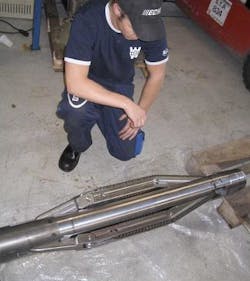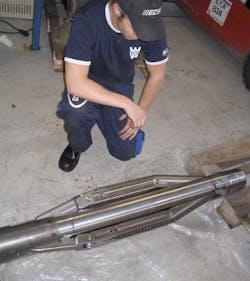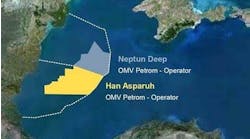Maritime Well Service (MWS) is extending its range of wireline tractors with the development of a tractor for use in open-hole wells. The program, under a technology agreement with Statoil, will lead to testing of a prototype this summer.
MWS’ cooperation with Statoil on tractor technology goes back to the world’s first down-hole tractor in the late 1990s, for use in cased wells. Now known as PowerTrac Advanced, Statoil uses the electro-hydraulic tool regularly, which estimates savings of NKr 2-2.5 million on each well operation compared with other intervention methods. It also claims that the tractor helped it reduce its operating costs in 2003 by around NKr500 million.
The open-hole tractor, designated PowerTrac Invader, is used for conveying logging equipment into the horizontal sections of uncased development wells. Logging is undertaken prior to the installation of tubing or casing to determine whether hydrocarbons are present in the formation.
Speed is of the essence in this operation. “The faster you can perform the logging, the better,” says Ole Petter Thomesen, president of MWS. “The longer the open-hole section is left exposed, the more likely it is that drilling fluids will contaminate the formation, the greater the risk of collapse, and the more likely it is that problems may arise later.”
The advantage of the open-hole tractor is that it enables the logging instruments to be transported to the horizontal section and subsequently retrieved significantly faster than the existing method of conveying the instruments on the drill-pipe. And because logging can take place sooner, the quality of the data acquired is better.
The PowerTrac Advanced tractor moves along the well by means of hydraulically driven wheels, which engage with the casing. But in the open hole, with its walls of sand, clay, and rock, the wheels would be unable to get a grip, so a new method had to be developed to enable the tractor to propel itself forward.
Working with ChainTrain, also located in Stavanger, MWS has developed a chain-based traction method. Once the tractor enters the horizontal open-hole section, chain-tracks are hydraulically deployed to engage with the sides of the well, giving a good contact with the surfaces.
“We have a good idea of the compressive strength of the formation, so we can adjust the force with which the tracks engage the walls,” says Thomesen. “This is important, as too much force might damage the formation, while too little force will not give the necessary traction.”
The development project, which started last fall, is on schedule to deliver an operations-ready tractor within 12 months. Following completion of detailed engineering earlier this year, a prototype will be built in the spring. Testing is due to take place in 3Q 2005 in a well Statoil will assign.
The PowerTrac Invader is the third tractor in MWS’ range. The PowerTrac Advance comes in two versions. One is a 3 1/8-in. diameter model, which is 4.3 m long and has a maximum pull of 1,000 lb. The second, which is being introduced this spring, is a 2 1/8-in. model, 3 m in length, and with a maximum pull of 500 lb. This model has been developed for use in the growing number of slim-hole wells. The PowerTrac Invader has a pull of 2,200 lb at 5 m/min; each drive section is 2.5 m long.
Thomesen attributes much of the success of MWS’ tractor technology to the company’s policy of working closely with its customers. “Our approach is that 80% of our R&D should be linked to the customers’ requirements. Thus they become involved in defining the scope of our R&D projects. While the benefit for us is that we end up with a practical product that we know the market wants.”
ONS shortlist
The PowerTrac Advance has undergone extensive further development since it first appeared, turning it into a very versatile downhole tool. Originally it was used only to carry logging instruments, but now it can handle a range of functions, including plug-setting and retrieval, perforation runs, operating shifting sleeves, and operating rotating equipment.
The latter capability enables it to be used for operations such as milling scale and concrete debris from well walls, refurbishing leaking seal surfaces, drilling out stuck flapper valves, and sand removal. These functions secured inclusion for the tool on the shortlist for last year’s ONS innovation award.
The tractor is showing clear signs of taking over tasks managed conventionally with coiled tubing, Thomesen says. It performs well across a wide range of down-hole conditions, even in very demanding high-pressure/high-temperature wells. Its operational uptime record is 98%, Thomesen says. It requires only two operators, and, weighing only 200 kg for the tractor and control system, can easily be transported by helicopter, enabling it to mobilize rapidly.
It is also suitable for remote control from an onshore operations center, as was demonstrated recently when it performed a downhole service from Statoil’s Heidrun platform, controlled from shore.
MWS has so far concentrated its marketing on the North Sea, where its tractor technology has gained good acceptance among users such as BP, ConocoPhillips, ExxonMobil, and Talisman in addition to Statoil. With a solid track record now established, the company is planning to start marketing further afield.




